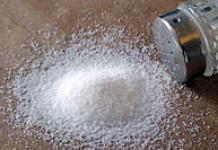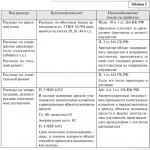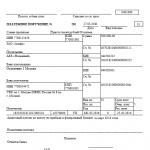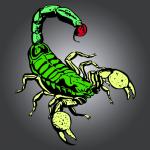Thus, it is possible to avoid many problems.
The plantation is treated for pests to avoid the appearance of the following insects:
- Kidney mites.
- Fires.
- Spider mite.
- Glassware.
- Willow scale insect.
All these pests cause great harm to the currant plantation. In particular, glass beetle and willow scale lead to the death of shoots and plants as a whole, and bud mites, moths or aphids will deprive the harvest because they interfere with the vegetative development of the plant.
For diseases, treatment is needed both as a preventive measure and as a fight against numerous damages that occur when a plant is affected by various types of fungal infections:
- Terryness.
- Anthracnose.
- Powdery mildew.
- Septoria.
- Rust.
All these diseases are caused by fungi and, despite affecting various segments of the plant, ultimately lead to the death of the plant. It is also dangerous that if one plant becomes sick, there is a possibility of infecting others. This will lead to the loss of the entire plantation.
For example, in the absence of prevention and treatment when terry appears, one bush will first suffer, and after a couple of seasons the plantation will lose most of the bushes.
What to process
To begin with, you should immediately decide. Treatment with pesticides is allowed only as a last resort. The basis of the treatment is spraying, it occurs using any available sprayer, in the absence of which it is possible to use a watering can with a millimeter nozzle.
There are two methods of treatment with infusions and carcinogens with chemicals. composition. Complex chemical compounds can be purchased at an agricultural or garden store. Their price will be quite low, due to their frequent use in large volumes.
The recipes for use are different for each solution: 
- Burgundy liquid. A one percent solution is required. Bordeaux mixture is used in the same way. 40 grams of the substance are diluted per bucket of water.
- or copper oxychloride is used at the rate of 20 grams per ten liters of water.
- Preparations Topaz, Vectra, Karbofos used according to the instructions, but in all cases a 10% emulsion will be needed.
- Application of iodine is still a priority. In a 10 liter bucket, dilute 10 ml of iodine and treat the desired plant.
- Fitosporin, is not a chemical drug and acts in the same way as iodine.
It is possible to use traditional methods: an infusion of tobacco, onion or garlic works well to repel various pests due to its specific pungent odor. This infusion is quite easy to obtain. In the case of tobacco, we grind it, in others we chop it finely. 100-150 grams per ten liters of hot water. Infusion should occur within 3-4 days.
Autumn processing
The autumn stage of treatment against various pests is not limited to treating the affected areas of branches and spraying them.
Work with a currant plantation begins in early spring, before the buds wake up and the sap flows:
The peculiarity of spring processing is a step-by-step mode for all types of currants:
- The first stage is thermal treatment.
- Trimming every other day.
- Feed if necessary.
- Preventative spraying before flowering with Burgundy liquid.
Treatment of currants against diseases
- In the spring, after the usual prevention, it is necessary to spray the currant bushes and the soil under them with a solution of karbofos or nitrophen, both solutions should be 2 percent. This procedure protects the plant from almost all diseases.
- After 10 days treatment is carried out Bordeaux mixture.
- And when kidneys appear, prevention is carried out spraying the bushes with fundozol.

If you follow the basic rules of plant prevention and care, it is possible to avoid almost all known currant diseases.
Spraying for pest control is also carried out with karbofos and nitrophen, which perfectly protect currant bushes from both diseases and any pest:
- It is important to remember that the fight against kidney mites is carried out at a temperature of at least 20 degrees If the temperature is lower, then after treatment the bush is wrapped in polyethylene, which is then removed after a few days. Treated with Karbofos or colloidal sulfur.
- To combat the moth, ordinary roofing material is perfect. It spreads around each bush, its edges are covered with earth. After flowering ends and the berries begin to ripen, the roofing material can be removed.
- Spider mites are plagued by simple processing with infusion of garlic or onion
- The large currant aphid also really does not like infusions of garlic or onions., need to be treated a couple of weeks before flowering
- Narrow-bodied borer is removed with a solution of karbofos. Moreover, the treatment occurs 20 days after flowering, the leaf gall midge is destroyed by spraying with chlorophos or karbofos.
The amount of fertilizer primarily depends on the quality of the soil itself and the age of the bush. There is no great need to fertilize soils with a high salt content with organic fertilizers, black soil or mineral salts.
Before the first frost, the currant plantation is watered abundantly. One bush should require about 70 liters of water. After watering, the soil is fertilized with compost or sawdust.
It is necessary to replant currants after the end of the growing season, when the leaves have dropped: 
- When replanting, the bush is pruned; cuttings can be made from the trimmings and buried there. If the cuttings are planted correctly, new bushes can grow.
- You need to dig the planting hole in advance to add fertilizer to it., as is done when planting a new plant.
- The bush is dug out along with the soil located in the roots, it is important to try not to damage the root system, and transfer it to the right place.
- After transplanting is completed, abundant watering is required., regardless of weather and soil moisture.
- Next comes processing and fertilizing the soil around the bush.
Subject to agrotechnical laws and regular proper care, currants become virtually invulnerable to pests and diseases. Strengthening the immune system is also done with the help of applied fertilizers, but it is important that this is always done on time and in the right proportions.
When planting or replanting a currant bush, the required amount of fertilizer is applied. Therefore, the bush does not need to be fed for 2 years. In the 3rd year, feeding currants occurs at the beginning of the growing season and at its end.
To make preventive treatment of currants in the fall more effective, a bedding made of crushed oak bark or simple sawdust is made under the bushes. This will allow the root system to be protected from drying out and low temperatures.
A short list of what you can feed:
- When the fruits ripen, Uniflor-micro is used. The dosage is 50 grams per bucket of water. After the end of the growing season, a mixture of potassium and phosphate is added.
- In spring, currants are fed with nitrogen fertilizers such as ammonium nitrate. The calculation is 70 grams for each bush.
- Manure or possible replacement with slurry or bird droppings. But in this case, fertilizing is applied directly at the rate of one bucket per bush, having previously dissolved potassium salt and superphosphate in a mixture of water and manure.
- The application of a mixture of mineral and organic fertilizers occurs when digging between the rows. About 10 kilograms of humus or rotted manure and potassium salt in combination with phosphates are applied directly under each bush.
All necessary chemical mineral fertilizers can be purchased at an agricultural or garden store.
When carrying out processing you need to know that:
- When transplanting or replanting bushes, preference is given to a new location in low areas on the western or northern slopes. In addition, if possible, heavy loamy or medium soils are recommended for black currants, and loamy soils for red currants.
- Before planting or transplanting, holes are made a couple of weeks before the possible planting time– this allows the soil to settle sufficiently and be saturated with fertilizers.
- The size of the hole for a currant bush reaches 40 centimeters diametrically, while the depth does not exceed 30-40 centimeters.
- Complete disposal of aphids will occur only after complete disposal of. Ants are almost impossible to remove using traditional methods. Most chemicals also have little effect on them. The only way to get rid of it is to use modern highly effective baits and gels. They act after some time so that the ants have time to deliver it to the anthill and feed the larvae and the queen itself.
- When pruning, it is easy to distinguish young shoots from old ones by their dark brown color and small cracks in the bark. They are also distinguished by underdeveloped and short growths. And, of course, berry shrinkage is noticeable in the summer on old branches compared to other shoots.
- A dangerous pest is the bud mite, whose presence is indicated by overgrown buds. If there are only a few affected buds, they must be removed. If the lesions are quite significant, then the bush must be cut off and immediately burned. To repel bud mites, garlic and onions are planted among currant bushes.
Taking a quiet look at any garden plot, you will probably see black currant bushes there. Amateur summer residents grow various varieties of this natural miracle, rich in nutrients and especially vitamins, and, as a rule, devote a lot of time and effort to this difficult task!
It also happens that at a certain moment in the development of currants, the gardener notices that his plants are affected by pests and it is clear that in this case one should not expect a good harvest of berries. In addition, it is important to understand the fact that if at least one plant is infected, then all currant plantings may die.
Are currants sprayed when they bloom?
Of course, in the case of pests, everything is simple - just say, treat the plant and voila! However, what if you notice the pests too late and the currants have gained color???
Use of chemicals
Experienced gardeners say that it is simply impossible to spray any plant, including currants, with any chemicals during the flowering phase! The berries will be enriched with harmful substances and will no longer bring the desired benefits, as in the environmentally friendly version.
We should not forget that currants of any variety are pollinated at the moment of flowering. To a greater extent, insects “participate” in this matter, which can simply be poisoned when treating inflorescences with pesticides!
Folk remedies
Along with this, it can be noted that such treatments - spraying against various types of pests are quite real and appropriate when using folk remedies. That is, you can easily treat flowering currants against pests by diluting the infusion with onion or garlic peels, using mustard powder or something similar.
For such spraying, ash solutions are often used, prepared on the basis of ash obtained from burning straw, firewood or even dry sunflower bushes. It will also not be harmful to add laundry soap or add a few grains of potassium permanganate. Some formulations even contain acetic acid, which also does not have a very negative effect on the quality of future berries and on insects.
Consequences of spraying
It is clear that any use of chemicals at the time of currant flowering is undesirable, but it also happens that sometimes it is better to sacrifice this year’s harvest than to lose an entire currant bush, or even worse, an entire row of currants. To protect insects, the bush can be covered with thick fabric for several days. It is clearly undesirable to use fruits from such a plant for food, but when there is a question of severe damage, you don’t have to choose!
The use of folk remedies when spraying at the time of currant flowering will also not always be safe. The fact is that any composition or solution prepared by you must be used at such a moment as correctly as possible, and in the case of the wrong dosage, you can burn the plant and the currant will simply drop its inflorescences!
Taking all this into account, breeders and experienced gardeners know that currants are best treated for pests in early spring, before they bloom, or in the fall, after harvesting!
Today it is difficult to find a personal plot in which a crop such as currants would not grow. This berry is valued not only for its delicious taste, this fruit is also very healthy. Due to these excellent qualities, this culture has become so widely used.
Why is spring treatment needed?
What to do before processing
When is the treatment carried out?
Insect pest treatment
Kidney mite
Currant aphid
Golden butterfly
Defect Treatment
Why is spring treatment needed?
Treating currants against pests is the key to harvesting and preserving the fruit-bearing bush. As a rule, gardeners begin caring for this crop as soon as the last snow has disappeared from the front garden. If you carry out spring processing correctly, you can count on a good harvest. Moreover, it is believed that treatment performed in the spring is the most effective.

What to do before processing
Before you find out how currants are processed in the spring, you should remember what measures are taken immediately before spraying. The fact is that protecting this crop is not only about timely spraying. In the overwhelming majority, the simplest manipulations cope no worse with such a task as protecting the currant front garden.

When is the treatment carried out?
The above deadlines for carrying out such procedures are optimal. It is important to understand that it is completely wrong to process shrubs at the moment you want. And you shouldn’t expect any good from such a procedure.
It is worth noting one very important point: there are certain periods when spraying this crop is strictly prohibited. These periods include the height of flowering.
The fact is that any drug, even if it is natural, can damage the opened buds, as a result you can forget about the harvest. But as for the question of whether it is possible to spray currants when the berries have appeared, most gardeners say it is possible.
After currants bloom, experienced gardeners recommend carrying out a treatment and preventive course, which consists of three stages. In this case, you need to maintain an interval of 10 days. This procedure is performed to completely saturate the soil and prevent the attack of various defects.
Insect pest treatment

Currant aphid
Golden butterfly
This individual is also not averse to eating the tops of young shoots. If the borer has settled on your currants, then you can identify it by the following sign: first the tops of the branches begin to dry, and then the affected branches dry out completely.
The main thing is that regardless of whether you use boiling water or soda, the kidney mite literally dies after the first procedure. Which is what is necessary to protect the bushes. The only thing to consider is that the treatment is carried out at a time when the weather outside is warm and fine.

Defect Treatment
Overcoming any disease on a currant bush is a rather complex and painstaking task. Therefore, try to initially organize proper care for this crop. Especially if you are a supporter of natural products and do not accept processing with chemicals.
It is worth emphasizing that in the case when a mistake was made in care and illnesses began to gradually destroy the currants, the fight should be started immediately.
But first, it’s worth studying the enemy in detail, namely:
- Terry: the first symptoms of the attack are practically invisible, noticeably manifested already during the ripening period of the berries. If you do not start the fight in time, you may be left without a harvest. You can identify it by the web with which it envelops the berries.
- A defect of fungal origin called anthracnose. This disease can be detected by a changed leaf blade, which becomes longer and slightly deformed. Anthracnose must be combated immediately as soon as its presence is noticed, otherwise the harvest will decrease several times.
- And the last, no less dangerous defect is powdery mildew. Not only currants suffer from this disease, but also other fruit crops and even cucumbers. If you do not want to lose your currant bed, you should act with lightning speed.
All the diseases described above can be overcome only with the help of potent chemicals. Moreover, it is possible to cope with defects only if they were identified at the beginning of development.
It is for this reason that you do not wait until one of the defects described above appears, because you already know what to spray the currants with. Carry out spring preventative treatment and let your bushes delight you with only tasty fruits.
Which we talked about last time, gardeners have to fight pests - various insects that damage currant bushes. What treatment should be done against pests in spring and summer? What preparations should I use for spraying currants?
Kidney mite. Its females invade the kidneys, which causes them to swell. These round, thick, large buds are clearly visible on bare branches in the fall, after the leaves fall, and in the spring, before they bloom. Collect these swollen buds from the branches and be sure to burn them. This is the simplest and most effective method.
If there are a lot of buds on a branch, then it should be cut out entirely and burned. If a large part of the bush is infected, then it must be cut off completely, at the root, and also burned. A new bush grown from replacement shoots in this place usually has no buds.
Among other pests, currants are most often attacked blackcurrant sawfly. The pest appears when large ovaries form and lays eggs on them. The larvae develop inside the growing ovaries, eating away the seeds in them. The berries ripen prematurely, they are clearly visible at this moment. We must collect them and destroy them.
If this is not done, the caterpillar will gnaw through the peel, come out, descend on a cobweb to the soil and go there for the winter. Since the larva develops at the moment when there are already green berries, no pesticides can be used, but you can use “Fitoverm” or “Agravertin” if you don’t have time to collect prematurely ripened large, ribbed berries.
Another common pest is gooseberry moth. Moth pupae overwinter in the top layer of soil, right under blackcurrant or gooseberry bushes. Just before flowering, butterflies hatch from them, come to the surface and lay eggs on the flowers. The larvae gnaw into the ovaries and eat them, then move on to the next berries, and each of them can damage up to 6-8 gooseberries or up to 10-15 black currants. These berries, entwined with cobwebs, are clearly visible, the main thing is to collect them on time.
If significant damage was caused by the moth in the previous summer, then in the spring, just before flowering, the bushes can be treated with Karbofos. Or cover the soil under the bushes with newspapers or film to prevent butterflies from coming to the surface. But immediately after flowering begins, the shelter should be removed to release beneficial insects.
You can use the biological products “Fitoverm”, “Iskra-bio” (or “Agravertin”). Try another old-fashioned way. In late autumn, the bushes need to be hilled up or mulched with peat to a height of 8-10 cm, and in the spring, immediately after flowering, they need to be mulched.
There is another fairly common common pest of gooseberries and black currants - gooseberry moth. An elegant, white, daytime butterfly, with a scattering of black and yellow spots on the wings. It appears in June-July and lays eggs on the underside of the leaves. Hatching caterpillars eat leaves, mainly on gooseberries, but do not disdain the leaves of black and red currants.
The caterpillars are grayish, with a yellow belly and characteristic black quadrangular spots on the back. They pupate in mid-summer in cobweb cocoons that hang on bushes. The simplest thing is to remove the cocoons and destroy them. A good method of combating moths is to spray the garden with urea in the fall. Of course, you can preventively spray currants and gooseberries with Fitoverm as soon as a noticeable butterfly appears or you find its caterpillars.
A very nasty pest of black currants - glassware, the nursery of which is the common bird cherry. The massive flight of this inconspicuous small butterfly occurs during raspberry flowering. At this moment, protective measures should be taken.
To do this, it is enough to spray the blackcurrant bushes with any decoction or infusion with a strong odor, for example, pine needles, tansy, onion peels, wormwood, tomato stepsons. You can place tomato shoots among the blackcurrant bushes or put pine branches. (They can be kept until this time in the shade on the north side of the house after you have removed them from roses, clematis and other cover crops.) A foreign smell, mixed with the familiar smell of the host plant, the breadwinner, disorients the pest, and it flies past your bushes.
Females lay up to 60 eggs each, usually near cracks or damage to the bark of branches. The hatching caterpillar gnaws through the wood and then eats away at the core of the branch, gradually descending to the very bottom. During the first winter it usually hibernates inside the branch. In spring, a damaged branch is immediately visible because the flowers or berries on it dry out, and then the branch itself begins to wither and dry out.
If you begin to gradually cut off such a branch with pruning shears, you will see the black core. Gradually cut the branch until you reach clear wood that the caterpillar has not yet reached. All pieces of branches must be burned; if desired, the caterpillar can be found inside the cut stems. It is quite large, about 2-2.5 cm, white, with a beige head.

If you cut the stem down to the ground and there was a black pith in it the entire time, then the caterpillar has already left the stem and gone outside to pupate. Spraying with Fitoverm after blackcurrant flowering helps greatly against this pest.
Gallica is a small mosquito whose adult larvae overwinter right under the bush, in the soil. The flower gall midge emerges during the budding period, the leaf gall midge emerges at the beginning of flowering, and the shoot gall midge emerges during mass flowering of black currants. All types of gall midges, when infested in large numbers, severely depress the bush, causing a cessation of growth and development of shoots, and then drying out of the branches. The flowers usually acquire a reddish color and fall off without producing ovaries. Before flowering, the bushes can be sprayed with karbofos or Fufanon, and during the growing season use Fitoferm.
Shoot aphid can also attack currants. Aphids are sucking insects, so absorbable preparations should be used against them, and Fitoverm or Iskra-bio are best suited for this.
But you can get by with simple means. Since aphids have very delicate integuments, it is enough to burn them to kill them. You can use an infusion of pine needles for this purpose or take 3 tbsp. spoons without top of urea and add potassium permanganate until bright pink and spray. Better yet, just wash all the ends of the branches, since aphids always suck the juices from the youngest leaves and shoots, and they are located at the ends.
Aphids cannot be killed in one go. A flying female will fly in from somewhere and immediately lay hundreds of eggs, from which adults will grow within a week and also lay hundreds of eggs, so you need to fight aphids weekly, except in the case when Fitoverm is used. This drug is absorbed and keeps the defense against all sucking and gnawing pests for about three weeks.
Aphids have natural pests - predatory gall midges, as well as ladybugs and their larvae. As soon as there are too many aphids, ladybug larvae immediately appear. They are about 7-8 mm long, black or dark gray, with orange speckles on the sides. The larvae, like ladybugs themselves, eat aphids and their eggs.
If the bushes are sprayed with Fitoverm, then the pests that have tasted the leaves or juice stop feeding within two hours after spraying, since Fitoverm causes paralysis of the gastrointestinal tract, and after two days they die of starvation. If ladybugs or other beneficial insects or birds eat such insects, nothing will happen to them.
Among the pests of black currant are false scale, which sucks juices from the bark. It is clearly visible on the branches in the form of convex commas of a lighter color than the bark. If you scrape it off with a knife, don’t forget to lay a piece of film under the bush in the shape of a baby’s bib, so that you can then collect and burn the fallen scale insects. If this is not done, they will again crawl from the soil to the ends of the branches.
Scale insects have a strong shell - a chitinous covering that protects them from enemies and pesticides, but it does not save them from Fitoverm. It also does not save you from spraying with a concentrated urea solution in late autumn.
Discussion
“Just before flowering, butterflies hatch from them,” is a strange action, IMHO.
Comment on the article "Blackcurrant: pest control in spring, summer and autumn"
More on the topic “How to treat currants in the fall against pests and diseases”:
Blackcurrant: pest control in spring, summer and autumn. Dig the soil under the treated plant the day after spraying the garden with pesticides. As for plant protection products from pests and diseases, I do not use pesticides...
Garden diseases and pests: treatment in spring, April and May. How to treat currants and gooseberries against powdery mildew. Blackcurrant: pest control in spring, summer and autumn.
In the spring we dug up black currants. Can I transplant it now? Or should we wait until autumn? It gets along well with me even in the summer (I think this even makes sense. We picked blackcurrants - what next? Processing currants in the spring is safe...
Blackcurrant: pest control in spring, summer and autumn. In addition to the various blackcurrant diseases that we talked about last time, gardeners have to fight pests - various insects that damage currant bushes.
Blackcurrant: pest control in spring, summer and autumn. Among other pests, the blackcurrant sawfly most often attacks currants. Fighting black currant diseases. Treatment of currants in spring with safe preparations.
Black currant. There is a whole currant bush, I bought it in. You can replant the bush in both spring and autumn, but it is quite troublesome. I agree with Lind_a that it is best to plant raspberries at the end of summer - I am an inexperienced summer resident. I want to plant black currants and...
Diseases and pests of strawberries, gooseberries and currants: what to treat and feed in August. Treatment of currants in spring with safe preparations. Blackcurrant: pest control in spring, summer and autumn. Then you can start fighting on your own...
Blackcurrant: pest control in spring, summer and autumn. We've picked blackcurrants - what next? Diseases and pests of strawberries, gooseberries and currants: what to treat and feed in August. We've picked blackcurrants - what next?
How to treat bushes with berries. Pests and diseases of raspberries: spider mites, weevils, raspberry beetles and raspberry flies. Blackcurrant: pest control in spring, summer and autumn. If there are a lot of buds on a branch, then it should be cut out entirely and burned.
Blackcurrant: pest control in spring, summer and autumn. Garden pest control: what and when to spray currants. What preparations should I use for spraying currants? Kidney mite. It doesn’t save you from spraying either...
Blackcurrant: pest control in spring, summer and autumn. You can use biological products “Fitoverm”, “Iskra-bio” (or “Agravertin”). How to spray apple trees against scab, codling moth, flower beetle. Garden diseases and pests: treatment...
Blackcurrant: pest control in spring, summer and autumn. 1.tell me what varieties of honeysuckle to buy? I need 2-3 bushes, they somehow pollinate each other 2. Are blackcurrants planted in the fall or in the spring? what And the fact that the plum is wormy...
Hi all. We have finally organized the clearing of the garden, in the spring we will replace all the fences, so that we have uprooted all the centuries-old rubbish - the bushes are 15-20 years old, and we are pruning the trees. I have 2 questions for dear Blackcurrant: pest control in spring, summer and autumn.
Raspberries: disease and pest control. How to treat bushes with berries. Cherries have healing properties in the treatment of anemia, lung and kidney diseases, and specialists generally consider currants to be almost the most balanced berry.
Blackcurrant: pest control in spring, summer and autumn. pink hydrangea white hydrangea moss-blooms with white daisies sedum-blooms pink lupine-2-3 bushes strawberries with pink flowers autumn black currants-2-3 bushes yoshta-2 bushes 5...
Blackcurrant: disease control. Tilling the garden in spring. How to treat currants and gooseberries against powdery mildew. Scab on apple trees. Blackcurrant: pest control in spring, summer and autumn.
Blackcurrant in spring: how to prune a currant bush and plant cuttings. Blackcurrant: pest control in spring, summer and autumn. Is it possible to plant currants, honeysuckle, gooseberries now? What about cherries and apple trees? I found a good nursery with a decent...
Blackcurrant: pest control in spring, summer and autumn. Among other pests, the blackcurrant sawfly most often attacks currants.
Plant diseases.. Floriculture. Caring for indoor plants: planting, watering, fertilizing, flowers, cacti. Section: Plant diseases. (Bordeaux fluid leaves blue marks when it can be washed off with water). Does Bordeaux mixture burn leaves?
Throughout the entire summer season, it is necessary to inspect the plants in the garden in order to detect warning signs in time. Both black and red currants, diseases and pests of which can destroy the entire harvest, require your attention and care.
Black currants (as well as red, white, pink) are subject to the same scourges as gooseberries, so pest and disease control for both crops is essentially the same.
What is wrong with currants?
The plant is able to “signal” that it needs your help, so most diseases can be guessed by changes in the appearance of the bush.
Currants resistant to diseases and pests
To “insure yourself” and protect your plants from most diseases, purchase blackcurrant varieties that are resistant to diseases and pests:
- Zoya;
- Minsk;
- Kipiana;
- Binar;
- Katyusha;
- Primorsky champion;
- Goliath;
- Klussonovskaya;
- Kupalinka;
- Memory of Vavilov;
- Titania;
- Ceres;
- Temptation and etc.
Spheroteka (American powdery mildew)
The causative agent is fungi of the genus Sphaerotheca. The first signs of currant infection with Spheroteka are noticeable already in May: the leaves, stems of the bush, and subsequently the fruits become covered with a white coating (later the color turns brown). Then the berries become smaller and lose their sweetness, diseased bushes do not have time to grow and die. The development of the disease is facilitated by high air humidity and dry, nitrogen-rich soil.
Control measures
The affected parts of the plant must be immediately cut out and burned, and the bushes themselves must be treated with a fungicide (Fundazol, Topaz, etc.). To prevent spheroteca in the fall, it is necessary to remove fallen leaves and thin out bushes. Dusting with wood ash is also effective.
Septoria (white spot)
The causative agent is fungi of the genus Septoria. As with other fungal diseases, the most suitable conditions for the development of white spotting are high humidity, insufficient light, and dense plantings. Brown spots (2-3 mm in diameter) appear on currant leaves, which by mid-summer lighten in the center and turn brown at the edges.
Control measures
Infected leaves and shoots must be removed, then treated with 1% Bordeaux mixture. For prevention, you need to annually prune the bushes, dig up the rows, and remove fallen leaves from the area in the fall.
Anthracnose
Another common fungal disease familiar to many gardeners. The first signs are small reddish spots (diameter 1 mm) on currant leaves, which later begin to darken, swell and expand.
Control measures
In early spring, treatment with 1% Bordeaux mixture will help (repeat after harvesting). Since the fungus overwinters in fallen leaves, in the fall it must be carefully raked out from under the bushes and burned.
Rust
Currants are attacked by 2 types of this disease: goblet (yellow-orange “warts” form on the underside of the leaf) and columnar (characteristic small reddish spots on the leaves). After some time, the berries and foliage of the diseased bush fall off.
Control measures
When the leaves just begin to bloom, the bushes are treated with a 1% solution of Bordeaux mixture (or other fungicides), then the treatment is repeated during the formation of buds. The final spraying is carried out after flowering.
Reversion (terry)
A viral disease from which the plant cannot be cured. Signs of currant terry: the appearance of the leaves changes - they lengthen and become pointed; later, sterile flowers of irregular shape grow.
Control measures
Diseased bushes will have to be removed from the site; partial pruning of severely affected shoots will not help. To prevent the appearance of this virus, be careful when choosing planting material. Since the terry virus is carried by insects (bud mites, aphids), treat the garden with pesticides in a timely manner.
Striped mosaic
If currant leaves begin to turn yellow ahead of time, most likely a virus has appeared in the garden that causes striped, or veined, mosaic. A characteristic feature - yellowness - spreads along the veins of the leaf, forming a mosaic pattern.
Control measures
Unfortunately, it is impossible to cure currants affected by striped mosaic, so diseased bushes must be dug up and burned, and the area where the virus has spread must be disinfected with a 1% solution of potassium permanganate.
Currant pests
Insects are carriers of many diseases, so to protect the garden it is necessary to carry out timely treatment of currants from diseases and pests in spring and autumn. All means are good in this fight, so we recommend using both natural and chemical preparations; most importantly, do not forget about safety precautions - wear protective clothing.
To make it easier to figure out how to spray currants against diseases and pests, we suggest using our table:
| Scheme for treating currants from diseases and pests | |
| Time | Procedure |
| Early spring, immediately after the snow melts |
|
| Period of bud swelling |
|
| Before the bushes bloom (budding period) |
|
| At the end of flowering |
|
| After flowering |
|
| After picking berries |
|
| Late fall |
|
Bud moth
A small butterfly (wingspan 17 mm) yellow-brown. “Specializes” in red and white currants, attacks black currants less often. After wintering under the bark and at the base of the bush, the caterpillar comes out into the light and eats the contents of the currant buds. After flowering, the caterpillar becomes a butterfly and lays eggs in the berries, where the larvae continue to develop.
Control measures
For prevention, you need to remove shoots with loose bark from under the stump, rake out fallen leaves from under the bushes and burn them away from the garden. During the swelling of the buds, the bushes can be treated with Iskra-M.
Currant aphid
Curled leaves with reddish swollen spots and twisted young shoots are signs that the plant has been attacked by aphids. Colonies of this insect can be easily found on the underside of leaves, as well as on shoots where the pest overwinters.
Control measures
To destroy aphid eggs, the bushes are watered abundantly with hot water (before the buds open) or treated with an insecticide (Fufanon, Decis, Aktara, Insektor, Iskra, Inta-Ts-M, Inta-Vir, Kinmiks, etc.).
Ognevka
During flowering, moth butterflies lay eggs in currant inflorescences. Then the caterpillars begin to eat the berries and leaves, entwining them with cobwebs. Each caterpillar is capable of destroying 10-15 berries.
Control measures
Before and after flowering, currant bushes are treated with solutions of insecticides (Iskra, Fufanon-Nova, Bitoxibacillin). For prevention, before flowering, the ground under the bush is mulched with peat or compost, and in late autumn the soil under the currants is loosened and the bushes are hilled up.
Kidney mite
If in the spring you find too large swollen buds on a currant bush, similar to small cabbage heads, most likely a bud mite lives in them. When the larva becomes crowded in a bud, it moves to another, thus damaging a large number of currant buds. The tick can carry the terry virus.
Control measures
In early May, during budding, “suspicious” buds must be plucked out. Before flowering, when mites are most vulnerable, the bushes are sprayed with an insecticide (Tanrek, Fufanon-Nova, Decis, etc.).
Glassware
Spring treatment of currants from pests and diseases, for example, pruning, helps to identify damage to the bush by glassware. The caterpillars of this pest live in currant shoots and leave behind wormholes. They feed on the inside of the shoots, making passages, which is why the branches stop growing, dry out and die.
Control measures
Every 2 weeks it is necessary to inspect the bushes and cut off (to the white core) the drying shoots in which the caterpillars have settled. You can treat glass currants with the same preparations as when fighting mites or bud moths.
Protecting currants from pests and diseases is not too difficult and can be done by every gardener. The main thing is to follow basic agrotechnical rules, providing plants with timely care.




















